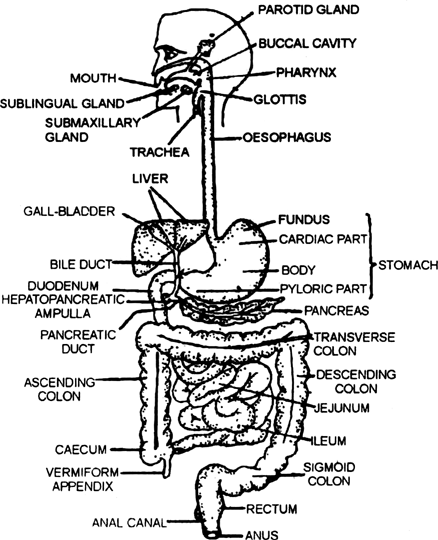 Short Answer Type
Short Answer Type Long Answer Type
Long Answer TypeAlmentary canal : It begins with an anterior opening – the mouth, and it opens out posteriorly through the anus.
i. The mouth leads to the buccal cavity or oral cavity. The oral cavity has a number of teeth and a muscular tongue. It is a transverse slit bounded by two lips—upper and lower. Both the lips are movable. The lips are externally bounded by skin and internally by mucous membrane
ii. The oral cavity leads into a short pharynx. The pharynx has a length of 12 cm. It is a common passage for air and food. T

Fig. Human digestive system
iii. Oesophagus : It is a tubular part of alimentary canal. It is also called food pipe. It has a length of 25 cm and runs parallel to trachea. The oesophagus passes through neck, thoracic and enters into abdominal cavity by piercing through diaphragm. It then opens into stomach. The anterior part of oesophagus has striped muscle and posterior part has smooth muscles.
iv. Stomach : It is J-like and present on the left side at the anterior end of the abdominal cavity posterior to diaphragm on the vental side. The stomach has three major parts – a cardiac portion into which the oesophagus opens, a fundic region and a pyloric portion which opens into the first part of small intestine. The food is temporarily stored and digested in stomach.
v. . Small intestine : It has a length about 6 metres and has 3 parts (i) Duodenum (ii) Jejunum (iii) Ileum.
a. Duodenum : It has length of 25 cm and hepatopancreatic duct opens into it. Food is digested in it and it is more vascular.
b. Jejunum : It is 2.4 m in length. Its wall is thicker than ileum.
c. Ileum : It is 3.6 m. The digestion and absorption occur in it.
vi. Large Intestine : Large intestine has a length of l.5m. It has three parts : caecum, colon and rectum. The caecum is vestigial. The blind vermiform appendix arises from caecum. It is tubular and vestigial organ. The colon has four parts : ascending, transverse, descending and sigmoid colon. Escherichia coli bacteria live in colon which are symbiotic and synthesize vitamin B and K for man. The colon opens into rectum having length of 15-20 cm. The rectum leads into anal canal having length of 2.5cm. It opens out by anus.
vii. Anus : It is an opening surrounded by two anal sphincters. The inner anal sphincter has smooth muscles and outer has striped muscles. Anus is surrounded by wrinkled skin called perineum.
 Short Answer Type
Short Answer Type Long Answer Type
Long Answer Type Short Answer Type
Short Answer Type